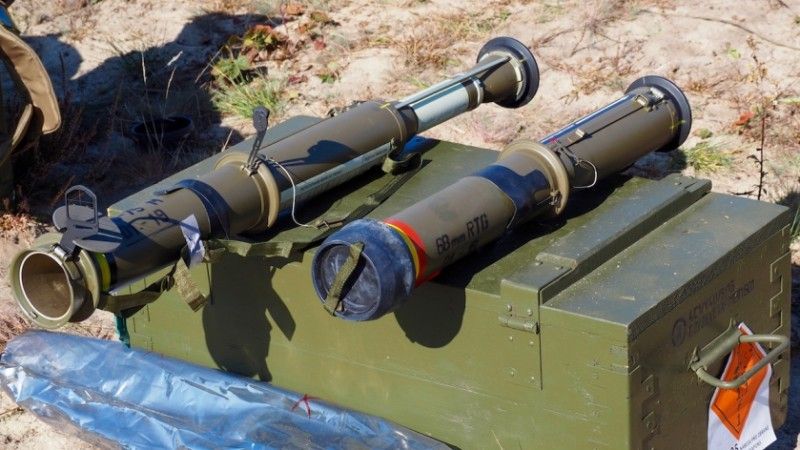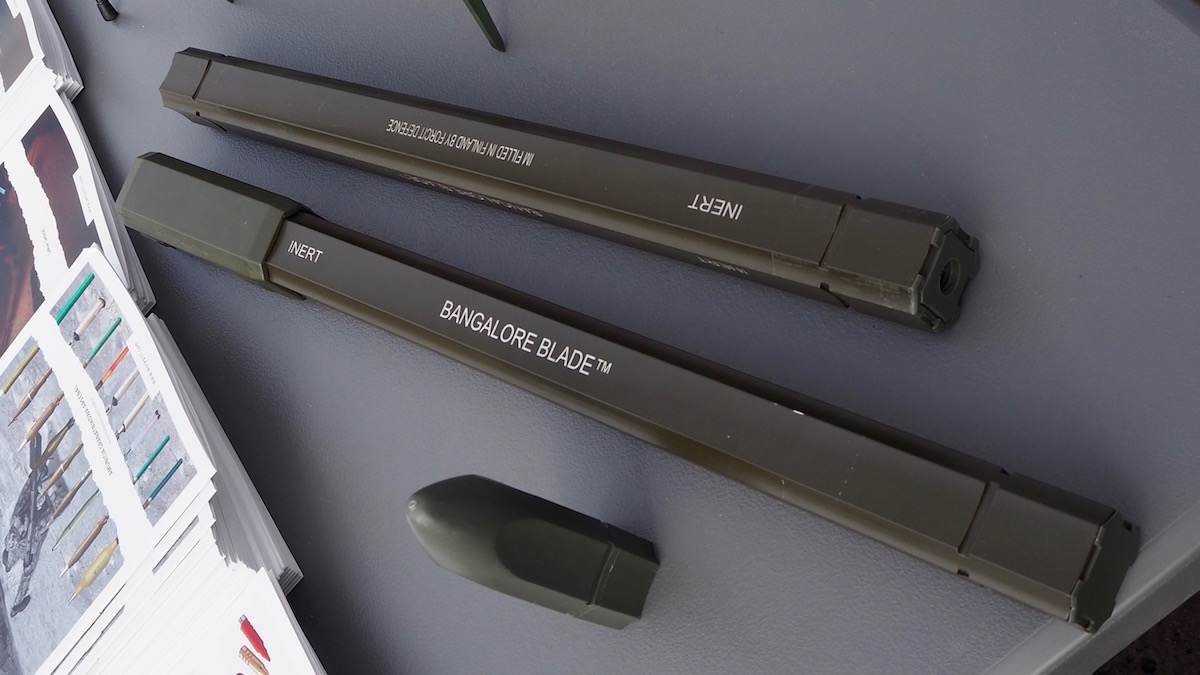Strona główna
Works11: Personal Artillery for the Infantry [Photos]

Demonstration of grenade launchers, ammunition and explosives took place at the training range belonging to the Military Institute of Armament Technology. The presentation was organized by the Works 11 company that showcased products which can be found in its offer. RTG single-use grenade launchers were presented, among other offerings. Manufacturing of this system could be launched at the Niewiadów facility that has been recently acquired by Works11. Modern rounds for the RPG-7 system and Forcit explosives were also demonstrated. Forcit is a manufacturer of Bangalore Blades and Hailstorm directional charges - presentation of these products took place as well.
Works 11 is a company that has been active on the market since 14 years now, working as a distributer of weapons and ammunition. The offer of the company has been presented at the range of the Military Institute of Armament Technology. The demonstration involved grenade launchers and explosives, and it took place in front of the representatives of the top command levels of the Polish military. However, the presentation was also attended by officers and soldiers of the Land Forces, motorized, air mobile and Territorial Defence Forces units included. Following the theoretical portion of the demonstration, the attendees had a chance to witness the use of the armament and analyze the effect on targets.
Single-use Artillery from Poland?
A particular emphasis was also placed on demonstration of use of the single-use 68 mm RTG grenade launchers with thermobaric warheads, RPG-75MP thermobaric-anti-tank warheads and RPG-75M anti-tank system. This is a family of single-use recoilless launchers with effective range of up to 300 meters.
[GALERIA_20014]
At this range the grenade launcher in question was quite accurate thanks to its compact design, diminishing the impact that the wind could have on the shooter. High velocity of the projectile (189 meters per second) is also quite important here. For the sake of comparison, in case of RPG-7 the very same performance figure is equal to 120 meters per second, with a much greater side surface.
RTG/RPG-70 fuse arms itself at a distance of 4-12 meters from the shooter. Thanks to this feature the risk of premature detonation is diminished, thus increasing the safety of use. Use in urbanized setting is facilitated by a small safety perimeter that needs to be kept behind the launcher - 2 meters from the wall.
The launcher, ready to use, weighs only 3.2 kilograms and comes in a form of a tube with a diameter of 99 mm that is extended before use (length: 630/980 mm). The tube features a simple sight with a clear instruction manual that has been printed on the launcher tube itself.
It is a weapon that has been used by the Polish Special Operations component since 2010. It could also become a part of the inventory of the Territorial Defence Forces or of air-mobile and mechanized units. RPG-75/RTG system is being readied for manufacturing in Poland by Works11. Niewiadów facility (Zakłady Sprzętu Precyzyjnego Niewiadów) owned by Works11 would be used for that purpose. Launching manufacturing of RTG, RPG-75M and RPG-75MP systems, the design of which remains virtually identical, depends solely on securing orders that could potentially be placed by the Polish military. In case as such, as Works11 representatives assure, it would be possible to launch series manufacturing of the launchers at the Niewiadów facility.
Old Designs Refreshed
Alongside the single-use system, the demonstration event organized by Works 11 also featured a broad range of new, modern projectiles designed for the RPG-7 system operated by the Polish military. The range of presented solutions included anti-tank, training, fragmentation and thermobaric warhead types. They were being presented in use against vehicles and obstacles. Firing the weapon at a distance of more than 1000 meters was also demonstrated. This has been made possible thanks to modern design of the projectile but also thanks to a special sighting system that allows the shooter to adjust the aim at distances of 1200 or even 1600 meters.
[GALERIA_20015]
Maximum range is different for different projectiles. It is also usable solely in case of thermobaric or fragmentation warheads, in case of which high level of precision is not really required to effectively neutralize the targets. Noteworthy, this expands the scope of usability of this weapon. The projectiles offered by Works 11 are supplied by the Arsenal AD company.
Finnish Directional Charges
Finnish Forcit company, on the other hand, showcased its Hailstorm directional mine that can replace conventional anti-personnel mines in line with the international regulations. The Finnish authorities decided, in 1997, to carry out research aimed at joining the Ottawa convention without losing the defence capabilities provided by the anti-personnel landmines. As a result of the steps mentioned above a process was launched, aimed at replacement of conventional landmines with their convention-compliant counterparts.
Hailstorm directional anti-personnel mines have become a part of the inventory of the Finnish forces in 2010. The directional charges can be activated electrically, wirelessly or via a wire. According to the manufacturer the mine can be used in any weather, at temperatures between -46 and +71 Celsius. Forcit Defence declares that the system may be stored for 25 years. It is also quite safe in transport, with its characteristics being proper for a highly stable munitions. During the field tests this was presented in practice - the mine was shot with a 7.62 mm rifle. Despite penetration, Hailstorm was only damaged, it did not detonate.
[GALERIA_20016]
The casing of the charge is made out of plastic. Firepower is ensured by fragments made out of steel or tungsten. Full-size Hailstorm is filled with thousands of fragments that make it possible to act against infantry at distances of 50 meters. 2 mm steel can be penetrated at distance of 80 meters, in case of the tungsten fragments. 60-degrees cone with a range of 50 meters is the area within which the mine is effective. A lighter variant - Hailstorm Mini - has also been developed, with the special operations in mind. It is a directional charge with a limited area within which effect on target is present.
The mine is very small, it weighs 900 grams and it acts against targets located within a field of 45 degrees, up to 30 meters from the device. At this distance the mine allows density of up to 5 hits per square meter. The lighter variant also comes with standard and tungsten-enriched fragments. Equipment as such may be used by special operations units and in urban environments. Different variants of both systems that had previuously been known as MPIMS are used by the armed forces of Finland, Estonia and the UK. They are also being introduced, currently, by the US Forces.
Bangalore Blade and Beyond
The range of the Military Institute of Armament Technology was also used to present engineering explosives manufactured by Forcit. Bangalore Blade is the flagship product here - it is used by combat engineers to clear obstacles that would otherwise require them to approach directly, possibly under fire, such as minefields. The charge can clear a fragment of terrain (with mines) that is 3 meters wide and with mines placed up to 1 meter underground. This happens both through explosive effect as well as thanks to fragmentation. At the same time, the charge can destroy barbed wire or concertina razor wire obstacles at a width of 10 meters.

This has been made possible thanks to the charge design - it is an aluminum shape with a square-like cross section with corners cut down and concaved sides. Making the body out of this material creates fragments the initial velocity of which allows them to cut through obstacles. After the detonation the fragments lose their velocity rapidly, diminishing the threat the explosive may pose for the user and bystanders. Bangalore Blade comes in 0.5 and 1 meter long modules that can be connected to create explosives of the size required.
During the presentation at the range three meters of Bangalore Blade were used to destroy 10 meters of concertina wire obstacle. The explosion created a gap in the obstacle, with the wire being disintegrated into harmless fragments and thrown far away from the passage.
The detonation was quite strong, but most of the impact went sideways. Safe space was located several meters behind the zone within which the charge had its effect present. Tools as such may also be used in urbanized areas, as rapid loss of energy of the fragments diminishes the possibility of collateral damage.
Alongside Bangalore Blade Forcit also presented its Peno explosive and a broad range of cutting explosives. These included Rebar Cutter cable/bar cutting charges and Dioplex linear cutting charges. The capabilities were presented with the use of cables and bars, and on steel plates and shapes. Rebar Cutter is factory-filled and available in three diameters, Dioplex linear charges, on the other hand, come in four sizes and are 1 meter or 0.5 meter long. They can cut through steel plates that may be up to 110 mm thick. What’s interesting, the charges may be factory-filled with explosive or come in a form of an open shape. In such case, the user fills in the shape with a proper quantity of plastic explosive.
All of the explosives listed here and armament have been demonstrated in use. In case of the grenade launchers potential users were given a chance to try them out personally.
